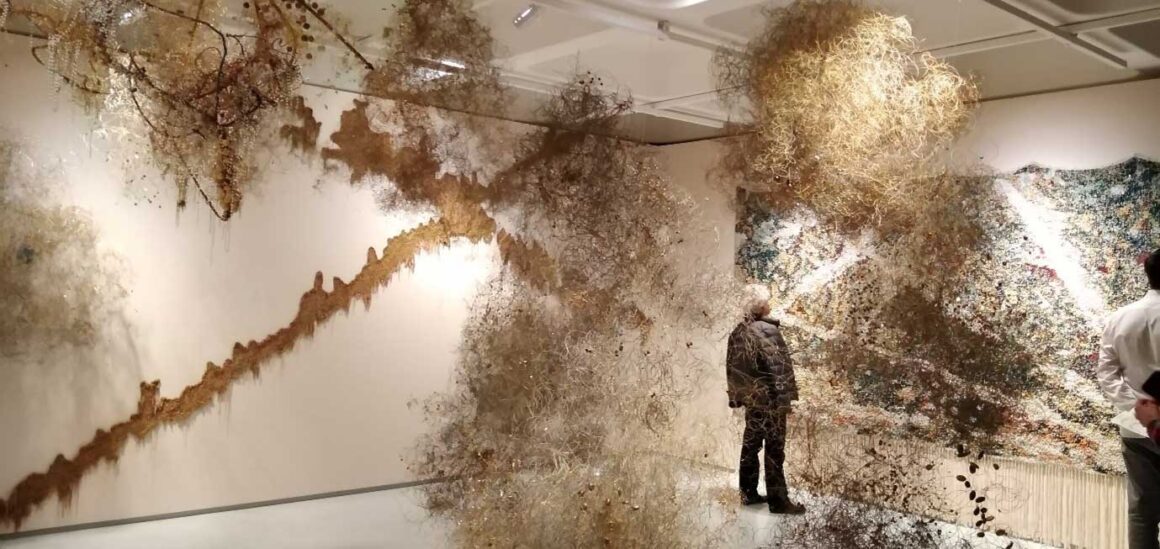

By Issobell Young
THIS IS an informative and thoughtful show with an international representation of many kinds of textile works, including sewing, knitting, embroidery, quilting, appliqué, weaving and dyeing. There are small and intricate works, large sculptural installations, and just about everything in between. Themes embodied in the works include sexual violence, racial murders, environmental degradation, gender identity and culture, and theft of land from indigenous peoples.
Some of the works are directly political and others more indirectly so, for example Magdalena Abakanowicz’s massive abstract fibre constructions, which she had to develop in a restrictive cultural environment in Poland where the dominant art and cultural institutions demanded a form of Soviet Socialist Realism. This style, promoted under Stalinism, was supposed to be non-abstract, optimistic propaganda showing happy workers living under successful “socialist” leadership.
There is nothing in this show similar to Soviet Socialist Realism, and one of its strengths is that it shows a wide range of approaches to creating ‘political art’, on a spectrum from representational images of oppression and resistance, to works which depend more on contextualisation to be understood.
A good example of this is a series of three embroideries done with hair, by Angela Su from Hong Kong. Drawn on textile, an eye is entered by a needle, vaginal lips are sewn together, and a nipple is pierced by a needle and thread. These were made in response to repression of protests in Hong Kong and also reference the protests made by immigrants in detention who sew their lips together to signify their inability to have their voices heard, and also to emphasise hunger strikes taking place.
Growing up gay under repressive regimes in Paraguay and Argentina, Feliciano Centurión, who died 1996 of Aids, was never allowed to openly explore gender fluidity and ‘femininity’ and thus he became interested in exploring sewing and crafts using cheap materials, as this was associated with women’s creativity and also relative poverty. This is a theme which is apparent in several other works in the show, where gay men have chosen textiles as a way to explore gender identities, notions of what art is appropriate for men, and what is not even described as ‘Art’, since it has been traditionally linked to women’s domestic tasks of repairing, making clothing, quilts and other household textiles. One way of making us see these crafty works differently is to make them on a vast scale, and several of the artists in the show do this. The small and domestic becomes the huge statement, for example in the native-American inspired works by Jeffrey Gibson, hanging from the roof in their vivid colours. Or a whole room becomes an artwork as in the beguiling installation by South African artist Igshaan Adams (born 1982) using wire, chain, shells braid, bone beads, inviting us to ‘carve out our own paths, but also to envisage collective acts of resistance’.
From the Philippines are textile maps by Cian Dayrit, made with local people, and Yuta Na Gi Panaad, (Promised Land), 2018) shows the location of dispossessions of land from residents by foreign multinational companies.
Finally, I want to mention, in my view, two of the most affecting works in the show, but very different in their appearance.
The first is a textile sarong woven by Zamthingla Ruivah memorialising a North Indian woman, Ms Luingamla, who was murdered by army officers in 1986 as she resisted their attempts to rape her. Nagaland has been under the Armed Forces Special Powers Act since 1958, when Naga separatist groups attempted to secede from India and since then the Act has been abused by security personnel to shield themselves from prosecution for crimes committed against the population. People can copy the design and wear the sarong in solidarity.
Teresa Margolles (born in Mexico) also creates works in memory and witness to deaths. Her American Juju for the Tapestry of Truth, 2015, made with members of Harlem’s Needle Arts Group, uses various materials to memorialise the deaths of Black men at the hands of the police, and the cloth was dragged over the spot where Eric Garner died while being arrested. She wants the works shown in this show to have a physical connection to the deaths, sometimes with the blood of the dead person, or traces of the place of death.
With works referring to wars, violence against women, racial oppression, political protest, creating queer identities in contemporary society and culture, the destruction of nature etc, this is a really interesting show to visit. It’s pricey, as most shows are these days, but every Thursday from 5 to 8 pm is a pay what you can afford slot, so take advantage of this!
Unravel. The Power and Politics of Textiles in Art runs at the Barbican until 26 May 2024.